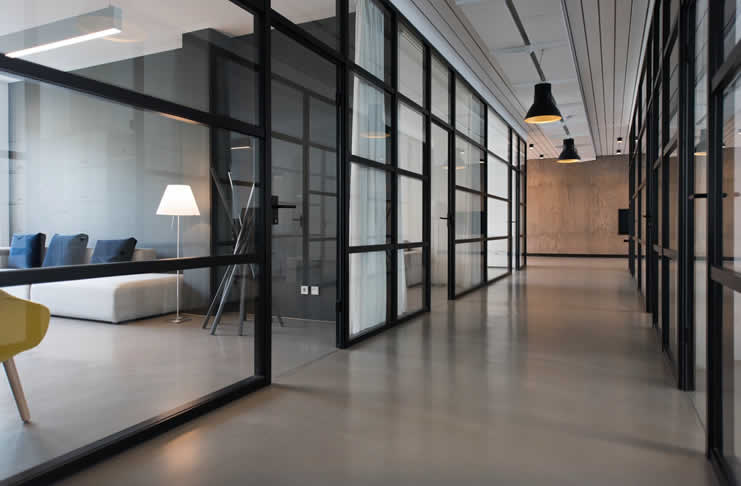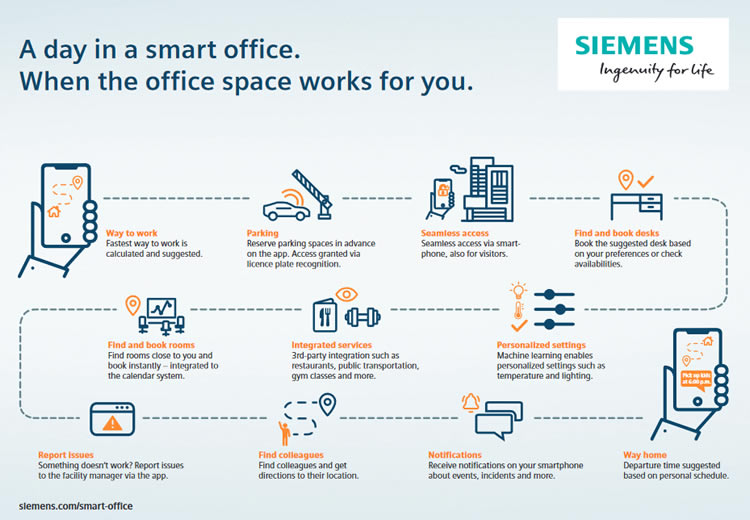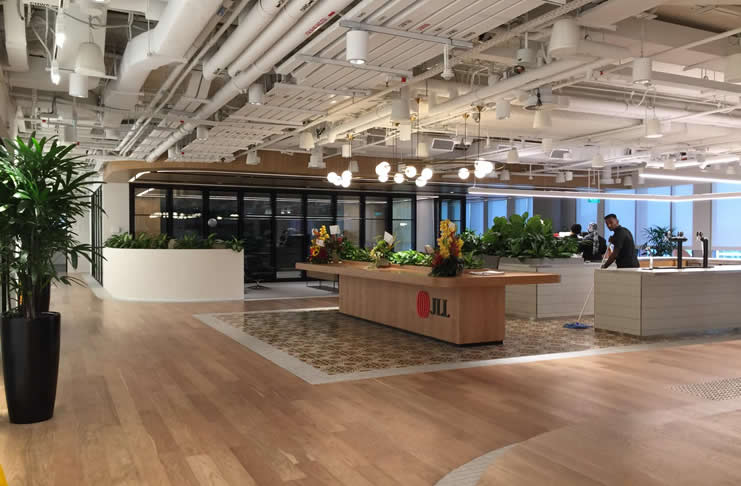For several years, organizations started transforming their offices into smart offices and workplaces overall into smart workplaces.
Several evolutions have accelerated smart office (building and technology) demand, driven by digital transformation and changing needs of all stakeholders as the office takes on a new meaning and its purpose evolves.

The impact of the pandemic on the future of work and increasing adoption of the hybrid work model is one of the accelerators and change agents. However, a range of existing drivers has become more important too, with dedicated, intelligent IoT solutions for numerous use cases as enablers.
A smart office is a smart workplace that traditionally combines several data-driven and digitally-enabled services and solutions to, among others, enhance worker experience and efficiency, realize cost and energy savings, and add value to the office (building) with apps for various stakeholders.
The more digital services people have to make their lives in the office easier and more rewarding, the more effective they are, and the more they enjoy their work. And the more they enjoy their work, the more committed they are…that’s also the reason why HR teams push to have resources for the smart office approach that’s sustainable, comfortable, healthy, modern, equipped with digital services, and simply more fun to work. (Youcef Gharoual, Solution Architect in the Schneider Electric Global Real Estate team)
These services are mainly based on the same technologies we meet in the broader context of smart buildings and spaces in general. They include IoT (Internet of Things), data analytics, cloud computing, and the technologies that existed to manage aspects of office buildings (e.g., HVAC, light control) for a longer time, and now increasingly get ‘smart’ and integrated into ‘smart’ vertical platforms. Other technologies that get used, sometimes for particular smart office use cases, are VR/AR and artificial intelligence, to mention a few.
The growing list of smart office services and use cases
The smart system that integrates the technologies, services, tools, and data analytics for smart office goals plays a central role with sensors and IoT technologies feeding the platform. Different use cases require different types of smart sensors and other components.
Workers, executives, facility managers, and potentially others typically dispose of mobile applications to activate/manage services they have access to and/or see analytics on key office parameters (depending on use case).
Smart office tools/services often also serve similar purposes as smart (office) buildings. Ensuring a ‘healthy’ office building/space is one example. However, the list of goals is longer and has lengthened in recent years.
The pandemic has accelerated the trend of the office being a space to foster productivity and socialization. Moving forward, however, variety, flexibility and choice will be core tenets of all successful office environments post-crisis. (Neil Murray, CEO JLL Work Dynamics group)
Some smart office priorities shifted as organizations are rethinking the office’s role while accelerating digital transformation efforts. Changing commercial real estate priorities (especially in office buildings and office space), a new generation of workers with particular preferences entering the office, the war for talent, the increasing importance of sustainability, an increasingly digital workforce, new technologies: the list of drivers is indeed long.
The accelerating and changing adoption of smart office services
Another list that is longer than you might expect is that of smart office (building) use cases and services/solutions. Yet, this doesn’t mean that a smart office is technology-centric. It’s people-centric and, especially now in the first place, worker-centric with the technologies as enablers.
And obviously, it serves the goals (and sometimes obligations) of other stakeholders thanks to the different, ideally integrated smart office services that offer analytics and thus insights to check and, if needed, enhance a broad range of elements such as in-office air quality or space usage.
Moving forward, office space needs to bridge the physical and digital worlds to meet the unique needs of every team — and even specific roles. Most organizations will require a mix of collaboration, meeting, and focus space, in addition to spaces that encourage informal social interactions. (Microsoft 2021 Work Trend Index)
These smart office services and the environment as such effectively need to be optimally integrated; within the broader environment and with partners’ services where such makes sense. We increasingly see that the vendors of platforms used for smart offices work with partners and startups, having very specific solutions that can be integrated in an open and easy way.
Really advanced smart office applications and integrations today mainly exist in some office buildings. For most, smart office use cases are rather limited, not present at all, or limited to applications that have been around for years (e.g., light and room control).
Many examples of advanced smart office environments you read about are realized by companies that also use them as showcases for their potential customers, as the JLL example below shows.
However, things are accelerating, and use cases and technologies are deemed essential for the return to the office and changing work models and attitudes in the context of the pandemic drive demand. This ‘return to the office’ already is a fact in some regions (e.g., in Asia), while in others (e.g., United States), it is far from done with ample discussions between workers and employers.
Research suggests the office provides a sense of community and belonging, where remote work has led to gaps in collaboration, leadership and managerial competencies (JLL)
Hybrid working and the hybrid work model (a continuum) are one subject of debate with differences per sector and with consequences for the smart office. Other factors accelerating the adoption of smart office technology include evolving regulations in many regions (energy performance, safety, health), future work evolutions, and the changing needs of end customers that impact how smart offices and office buildings are valuated.
A smart office is a space that fosters productivity and socialization as a new purpose emerges for the office
Before further exploring some of the before-mentioned topics focusing on the main stakeholders (workers, owners, commercial real estate execs, facility managers), a look at some consequences of evolved and/or ‘new’ elements, driven by the (impact on workers and organizations) of the COVID-19 pandemic. We start with the role and purpose of the office as such.
The fact that many workers couldn’t be in the office for often long times and sudden switch to remote work where possible inevitably accelerated or changed some smart office, business, and work priorities. Moreover, on some levels, such as wellbeing and mental health, the impact of the health crisis was so profound, with the usual contextual differences, that organizations simply had to adapt offices on at least some elementary safety levels and often in a quite profound way.
Smart offices always required a holistic approach. Today that’s even more so, with a combination of technologies, design elements, and spaces that focus on the overall wellbeing of workers and, thus, the organization’s success whereby people make the difference.
You could argue that smart offices are going to evolve into meeting points in a new paradigm in which everyone works from home, only dropping into the nearest office location when face-to-face interaction is needed. The system will automatically choose a hot office instead of a hot desk. It will be maintained by a facility management company that can configure things… (Martin Feder, Schneider Electric, on the impact of 5G on the future smart office)
That there is a link between digital services people want for work, work satisfaction, and worker commitment isn’t new. As Youcef Gharoual (Schneider Electric) put it in an interview before the pandemic: the more digital services people have to make their lives in the buildings easier and more rewarding, the more effective they are, and the more they enjoy their work. And the more they enjoy their work, the more committed they are to the environment and the organization. “That’s also the reason why HR teams push to have resources for the smart building and smart office approach that’s sustainable, comfortable, healthy, modern, equipped with digital services, and simply more fun to work.”
It’s become even more critical to think beyond technologies and solutions we know in domains such as light and room control, connected meeting rooms, occupancy analytics, location-responsive apps, and the likes since the pandemic as the office’s purpose changes and worker-centricity matters.
Moreover, the worker needs to be seen as one. It’s a known fact that demand for smart office solutions grew as ever more workers became acquainted with smart home technologies. Smart home automation is now the largest IoT spending segment. So, we saw more or less a repetition of what happened when smartphones hit the market, and the BYOD evolution started. Soon, for hybrid workers, the smart home will be driven by the hybrid work evolution once it’s more mature and proactive instead of mainly reactive now.
Per Neil Murray, Global CEO of commercial real estate solution company JLL’s Corporate Solutions division (recently rebranded as JLL’s Work Dynamics group), the pandemic has accelerated the trend of the office being a space to foster productivity and socialization. According to JLL, a new purpose for the office emerged, and the workplace looks different for many who return(ed).
As said, when writing this (Summer 2021), the situation regarding the return to the office differs a lot per region and country. People who have followed developments across the globe in recent years at times will have noticed that due to, among others, the evolution of the pandemic and the different approaches of governments, it seemed as if we lived in different worlds.
Forrester expects that smart office initiatives will drive employee experience transformation in 2021. While some companies will get rid of their expensive corporate real estate, driven by the health crisis, the firm expects “at least 80% of firms to develop comprehensive on-premises return-to-work office strategies that include IoT applications to enhance employee safety and improve resource efficiency, such as smart lighting, energy and environmental monitoring, or sensor-enabled space utilization and activity monitoring in high traffic areas”. Source.
The same happens with regards to the return to the office and attitudes of working with regards to the future of work and their workplace. For instance, in many Asian and some European countries, it’s as if the situation is more or less normal again, at least at first sight. Only around a third of workers returned to the office in the US, however, with quite remarkable differences per region and industry.
From a perspective of the purpose of offices, most debates revolve around the hybrid workplace and how to make the workplace more flexible and worker-centric. Demand for more collaboration space and drop-in space is high while topics such as health, wellbeing, ecological footprint, and space utilization rank high on the smart office agenda.
The pandemic hasn’t caused these evolutions; it accelerated them. Flexible working space was already occupying ever more office space before the pandemic started and quite some office workers de facto already worked in hybrid models, again with the usual differences.
Yet, the impact of a pandemic, that’s something no one saw coming and will continue to impact the development of smart offices that become hybrid hubs serving multiple purposes.
The adoption of smart office technologies evolves with the evolution of work models and the needs of workers, executives, real estate execs, facility managers, and others.
Their goals are, among others, to ensure a safe workplace, optimize space utilization and gain insights into occupancy, wellbeing, worker experience, and more factors that help them meet their goals and enhance the lives of workers.

A smart office strategy looks at the typical day of employees in a holistic way
Per JLL’s Global Chief Human Resources Officer Mary Bilbrey, employers need to shape their workspaces according to the new ways of working imposed by the pandemic and reinvent themselves to evolve alongside the workforce, rather than against it.
Evolving alongside the workforce, being worker-centric, pay attention to wellbeing, enhancing the employee experience, it’s clear that many newer apps will revolve around the worker’s (new) needs, as we see several companies already doing.
Small organizations will need a different approach than big employers. However, the good news is that even for emerging technologies and services/apps, there are solutions for all budgets.
What definitely hasn’t changed and even has become more important is the need to have a smart office strategy that takes the goals of all stakeholders into account. As far as employees are concerned, that means not just looking at comfort, productivity, choice, collaboration possibilities, etc. in the office.
It is about all aspects, including the trip to the office and back (the commute), the parking, the integration of other services, etc. Whatever can be made easier and enhance satisfaction and productivity. In that regard, the infographic by Siemens, depicting a day in a smart office, is a good starting point. And of course, so is talking with workers and others. There is no strategy without input and data, and without big data turned into services and insights, there is no smart office.
Smart office building case: JLL’s new APAC headquarters
By way of an example, we take a quick look at the new Asia-Pacific headquarters of global commercial real estate services company JLL. The building in Singapore, where the HQ is based, is also the first smart office pilot of the company.
Moreover, the building serves as a showcase for workplace evolutions as we continue to move to a more hybrid working model, welcome a new generation in the office, and realize that employee satisfaction and employee experience matter more than ever.

For Darren Battle, Head of Corporate Real Estate and Workplace, Asia Pacific at JLL, it’s clear: the human side of the business is essential – and always a goal for JLL.
Providing the best possible employee experience in the office is vital for operational excellence and, as is proven a long time ago, employee satisfaction and customer satisfaction are strongly related.
Striving to combine a people-centric design and an intelligent work environment, JLL turned to long-time partner Schneider Electric for the project. The latter recommended one of its’ EcoXpert business partners in the region: Automated Lifestyle.
An intelligent work environment puts people first while being sustainable, reducing energy consumption, enhancing efficiency, saving costs, enabling pro-active maintenance, offering resilience, and connecting the dots to realize these and other goals with the infrastructure and systems that fit the job best.
State-of-the-art technologies support the business and the worker objectives, which in practice mostly overlap (e.g., a healthy work environment), and that requires an open and smart system that brings it all together.
As Automated Lifestyle co-founder and director Esther Wong puts it, a smart office starts with a smart system designed to help the office operator measure and manage their energy usage and office wellness conditions. More on the case and goals you can realize with smart office technologies and additional cases, in detail, coming in a next article.
Photo at the top by Nastuh Abootalebi on Unsplash – photo of the JLL APAC headquarters: Automated Lifestyle.

